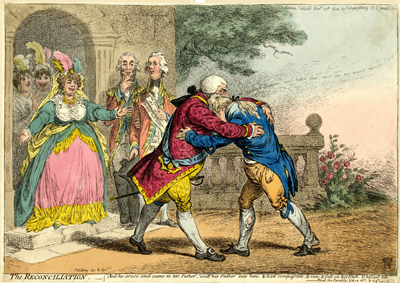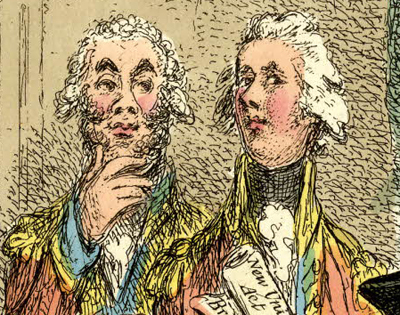The Reconciliation
The central action of The Reconcilation is based on the Biblical parable of the prodigal son in Luke 15:11-32. In that story, the heedless younger son asks his father for "the portion of goods that falleth to [him]" and when he had received it, took his share "into a far country, and there wasted his substance with riotous living." Soon thereafter, poor, starving, and repentant, he decides to return to his native country.
I will arise and go to my father, and will say unto him 'Father, I have sinned against heaven and before thee And am no more worthy to be called thy son; make me as one of thy hired servants.' And he arose, and came unto his father. But when he was yet a great way off, his father saw him, and had compassion, and ran and fell on his neck, and kissed him.
King James Version

© Trustees of the British Museum
Like the prodigal son, the Prince of Wales had, by any estimation, led a profligate life, with numerous mistresses, huge gambling debts that required Parliamentary intervention to pay off, and a luxurious lifestyle that was the exact opposite of his frugal and abstemious father. To make matters worse the Prince had shown a distinct lack of filial piety during the 1789 crisis when his father's plunge into madness seemed about to make him Prince Regent. And his perfectly shoddy treatment of the woman he agreed to marry in exhange for paying off his debts endeared him to no one—neither his parents nor the British population at large. But the most recent instance of estrangement resulted from the Prince's hostile reaction to his father's refusal to allow the Whig leader, Charles James Fox, to become part of a new coalition ministry formed by William Pitt in May of 1804.
So great things were expected when, on November 12, the father and son were finally reunited at Kew. Accounts of the meeting appeared in several newspapers over the next few days including The British Press, the Courier, the Morning Chronicle, and others. Here's the report from the London Star on November 13, 1804.
The long expected interview between the SOVEREIGN and the HEIR APPARENT took place yesterday, at one o'clock, at Kew Palace. The Queen and the greater part of the Royal Family were present. The meeting of those two Personages, after a long interval, was marked, we understand, by every emotion of kindness and conciliation on the one part, and of affectionate respect on the other. The scene is said to have been affecting beyond all description; and we are fully persuaded that the circumstance will afford the highest gratification to every loyal and feeling breast in the United Realms.
Casting the Prince as the prodigal son, Gillray sets the scene out of doors as in the Biblical account, portraying the prince as poor and disheveled, his clothes tattered and torn.* Using words deriving from the Biblical account in both the print's text and caption, he creates a touching version of the mutual embrace of repentance and forgiveness in Luke chapter 15. But he also includes details from the newspaper accounts, especially the presence of "the Queen and the Princesses" (who are specifically mentioned in the Courier account).
The biggest departure from both the Biblical and newspaper sources is the presence of two figures who were not present at the actual reunion, but certainly played a part in bringing it about. Those were the long-time friend and advisor to the Prince, the Earl of Moira, and the King's current Prime Minister, William Pitt. According to the Morning Chronicle of November 9th 1804, Moira had recently arrived in London and was rumored to have had "an interview with Mr. Pitt on important and delicate public business" (presumably on the 7th of November). In the same report, he is said to have "set off for Brighton [the next day] to pay his respects to the Prince of Wales." In February - March and then again in May - September, the King had suffered a return of the malady that nearly brought about a Regency in 1789. All the while, the country was still at war with France. So it's hard not to suspect that the "important and delicate business" between Pitt and Moira included discussions of a potential rapprochement between the King (and the King's government) and the Heir Apparent.
Gillray positions the two leaders side by side with no space between them, suggesting a certain (wishful) unanimity of opinion. Moira's pose is probably a parody of Sir Joshua Reynold's formal portrait of the Earl with its unusual hand to chin. (A mezzotint version of the painting had been published by John Jones in May 1792.) Pitt turns towards Moira as if he is about to whisper something while his eyes remain directed at the King and Prince. In his hand he holds a scroll with the words "New Union / Act / Britain's best Hope." Both men would have agreed that, especially at this moment, Britain's "best Hope" was indeed a reconciliation, a "New Union" between the father and son.

© Trustees of the British Museum
But if most of Gillray's print serves to celebrate the reconciliation of father and son, the presence of Pitt and Moira provides an ironic perspective characteristic of Gillray. For though the scroll speaks of unity, the word "Act" appears on its own line as if emphasizing the theatricality of the scene. And the expressions on the faces of both Pitt and Moira do not suggest secure satisfation but skepticism or, at best, a reservation of judgment. Both men were intimately familiar with the stubborness of their royal partners and the depth of their political disagreements. That skepticism was soon justified. Already by November 17, William Cobbett in his Political Register was branding Pitt's actions and those of the pro-government press celebrating the reunion as "Ministerial Intrigues." And by December 1 he was announcing with unfeigned satisfaction their complete failure.
* Gillray's portrayal of the heir apparent was almost immediately castigated by William Cobbett and London und Paris. Cobbett called it a "scandalous outrage on the feelings of the Prince" in his Political Register of December 1. And in one of the more amusing comments by the German publication London und Paris translated in Gillray Observed, the editors felt compelled to point out that
To appreciate the excessive degree of malice in this travesty of the Prince of Wales, we must remember that for years the Prince has been, and indeed still is, regarded throughout England as the paragon and prime model of all that is most sophisticated and elegant in male attire.
Sources and Reading
- Commentary from the British Museum on The Reconciliation
- Draper Hill, Mr. Gillray The Caricaturist, 1965, p. 121n
- Christiane Banerji and Diana Donald, Gillray Observed, 1999 #19 pp. 206-214.
- The Prodigal Son, King James Version Luke 15:11-32
- "Parable of the Prodigal Son," Wikipedia
- "George III," Wikipedia
- "George IV," Wikipedia
- "William Pitt the Younger," Wikipedia
- "Francis Rawdon-Hastings, 1st Marquess of Hastings," Wikipedia
- Thomas Wright and R.H. Evans, Historical and Descriptive Account of the Caricatures of James Gillray #302
- Thomas Wright and Joseph Grego, The Works of James Gillray, the Caricaturist; With the History of His Life and Times, p. 312.
Comments & Corrections
NOTE: Comments and/or corrections are always appreciated. To make that easier, I have included a form below that you can use. I promise never to share any of the info provided without your express permission.